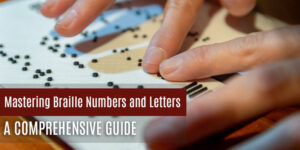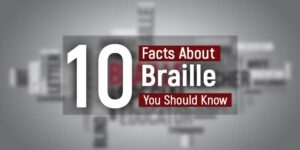Music has the ability to evoke strong feelings within people.
Are you passionate about making it available for all, including those with visual impairments? If this is something that interests you, here’s your opportunity: certified braille transcribing offers accessibility in music for those living with visual impairments.
Becoming a certified music Braille transcriber could be exactly what’s needed!
This blog will outline what a Braille transcriber does and the steps involved in becoming a certified music Braille transcriber in the USA.
Understanding the Role of a Braille Transcriber
A Braille transcriber is defined as any individual who converts text into Braille, an alternate writing system often utilized by people who are blind or visually impaired.
Braille plays an essential role in making content such as books, documents and music available to those who rely on Braille for reading and understanding.
Transcribers are responsible for translating musical notation to Braille format so that blind musicians can read and perform independently.
Benefits of Hiring a Braille Music Transcriber
- Accessibility
Braille transcribers ensure music is accessible to everyone regardless of visual impairment; this allows blind musicians to fully participate in musical activities and performances.
Accessing Braille music gives visually impaired musicians the independence they need for studying, practising and performing music – essential in cultivating musical growth and creativity.
- Education
Braille transcribers play an integral part in education. With Braille books and study materials accessible to blind students, they can actively engage in classes and workshops, unlocking their full potential and talent.
Making Braille music available level the playing field and ensure that blind musicians have equal opportunities to pursue their musical ambitions as their sighted peers.
Finding the Right Braille Music Transcriber
Finding an experienced Braille music transcriber can be difficult; here are a few steps that may help you locate one:
- Research
Conduct an in-depth search for transcribers or organizations who specialize in Braille music transcription. Check their qualifications and experience before selecting one as your transcription partner.
- Portfolio
Check their portfolio of previous Braille music transcription work to gain an idea of their proficiency and style.
- References
Speak to past clients or organizations they’ve collaborated with to gain feedback about the quality, professionalism and timeliness of their work.
Certification
Certified Braille transcribers have undergone intensive training and shown proficiency in Braille transcription. Their certification lends credibility to their abilities.
Here is a step-by-step guide that can help you become a certified braille transcriber
Step 1: Satisfy Eligibility Requirements
It is crucial that you fulfil the eligibility requirements set forth by renowned certification programs. Usually, these requirements include having an extensive understanding of music theory, notation and accessibility within the arts.
Step Two: Enroll in Music Braille Transcription Courses
The second essential step to becoming a music Braille transcriber is enrolling in specialized transcription courses. These are designed to equip you with the necessary tools for accurately transcribing musical notation into Braille format.
Look for programs recognized by organizations like the Library of Congress or National Braille Association that cover intricate details like Braille codes, music symbols and formatting – giving you an in-depth knowledge of transcription processes.
Step 3: Gain Experience
Start out slowly transcribing simpler musical compositions to Braille before gradually building up to more difficult works. Gaining hands-on experience not only sharpens your transcription abilities but also provides an opportunity to expand and diversify your portfolio of work.
Consider volunteering with organizations serving visually impaired communities or teaming up with music educators locally in order to increase exposure and experience.
Step 4: Take the Certification Exam
Once you feel confident in your Braille transcription abilities, it is time to take the certification exam. This test measures your proficiency at transcribing music accurately into Braille while meeting all standards established by the certification program.
Ensure you review exam guidelines, and practice sample questions, and dedicate enough time for preparation; passing this milestone test solidifies your status as a certified music Braille transcriber!
Step 5: Maintain Your Certification
The journey doesn’t stop after becoming certified! Certification maintenance includes keeping abreast of evolving Braille codes, music notation changes and technological developments in transcription tools.
Engage in continuous learning by attending workshops, conferences or online courses in order to stay ahead of these developments and offer accurate Braille music materials to clients.
Conclusion
Becoming a certified music Braille transcriber is a worthy goal that enables blind musicians to engage with the world of music. By following these steps — meeting eligibility requirements, taking transcription courses, gaining experience, and taking and maintaining certification exams– you are not only opening doors for yourself but also making a real impactful difference in people’s lives who share an affinity for music.







